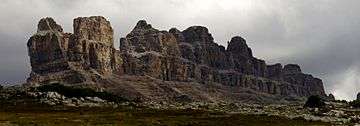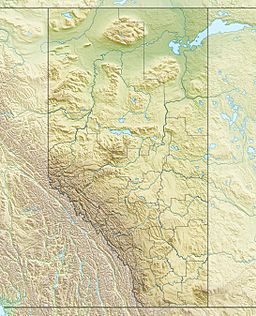Dolomite Peak facts for kids
Quick facts for kids Dolomite Peak |
|
|---|---|

Dolomite Peak close up
|
|
| Highest point | |
| Elevation | 2,998 m (9,836 ft) |
| Prominence | 366 m (1,201 ft) |
| Parent peak | Cirque Peak (2993 mn) |
| Listing | Mountains of Alberta |
| Geography | |
| Location | Alberta, Canada |
| Parent range | Canadian Rockies |
| Topo map | NTS 82N09 |
| Geology | |
| Age of rock | Cambrian |
| Type of rock | Dolomite and Limestone |
| Climbing | |
| First ascent | 1930 by J. Monroe Thorington, and Peter Kaufmann |
| Easiest route | Scramble |
Dolomite Peak is a huge mountain in Banff National Park, Alberta, Canada. It stands about 2,998 meters (9,836 feet) tall. This makes it almost 3 kilometers high!
You can find Dolomite Peak in the beautiful Bow River valley. It's part of the amazing Canadian Rockies. The mountain's closest taller neighbor is Cirque Peak, which is about 4 kilometers away.
Dolomite Peak is easy to spot from the Icefields Parkway. It has cool, colorful rock towers and jagged cliffs. These rocks are a mix of dolomite and limestone. Dolomite rock is special because it's rare in the Rockies and much stronger than limestone.
Discovering Dolomite Peak
How the Mountain Got Its Name
Dolomite Peak was named in 1897. Three explorers, Charles E. Fay, Norman Collie, and Charles Thompson, named it. They thought it looked a lot like the famous Dolomites mountains in the Italian Alps.
The mountain's name became official in 1924. This was decided by the Geographical Names Board of Canada.
First People to Climb It
The very first time someone climbed to the top of Dolomite Peak was in 1930. A person named J. Monroe Thorington made the climb. He had help from a guide named Peter Kaufmann.
What Dolomite Peak is Made Of
Rocks and How They Formed
Like many mountains in Banff Park, Dolomite Peak is made of sedimentary rock. This type of rock forms from layers of sand, mud, and shells. These layers piled up over millions of years in shallow seas.
The rocks in Dolomite Peak formed during ancient times. This period stretches from the Precambrian era to the Jurassic period. Imagine ancient seas covering this area!
How the Mountain Was Pushed Up
Later, a huge event called the Laramide orogeny happened. This was when massive forces deep inside the Earth pushed the rock layers. They were pushed eastward and stacked on top of younger rocks. This is how the tall mountains we see today were created.
Weather Around Dolomite Peak
Understanding the Climate
Dolomite Peak has a subarctic climate. This means it has very cold and snowy winters. The summers are usually mild, not too hot.
Winter temperatures can drop really low, sometimes below -20 °C. With the wind, it can feel even colder, below -30 °C!
Water Flowing from the Mountain
Snow and rain that fall on Dolomite Peak melt and flow away. This water is called runoff. It drains into the Bow River. The Bow River is a major river that eventually joins the Saskatchewan River.
Best Time to Visit
If you want to see or climb Dolomite Peak, the best time is usually from July to September. The weather during these months is the most pleasant.
Images for kids





